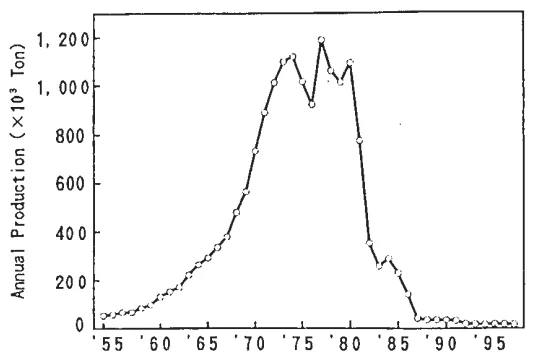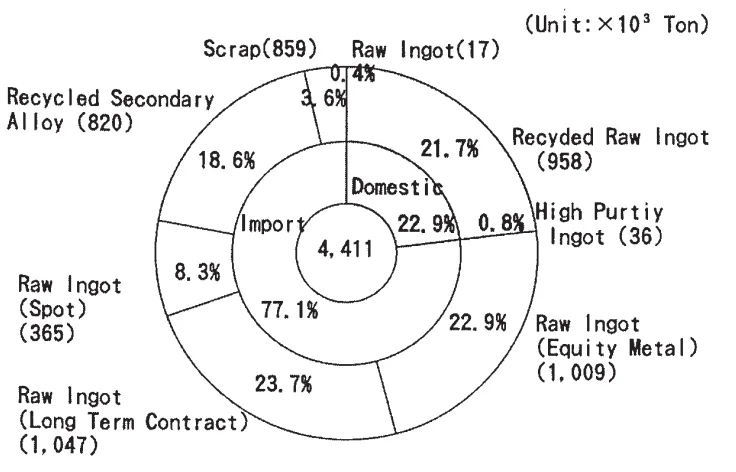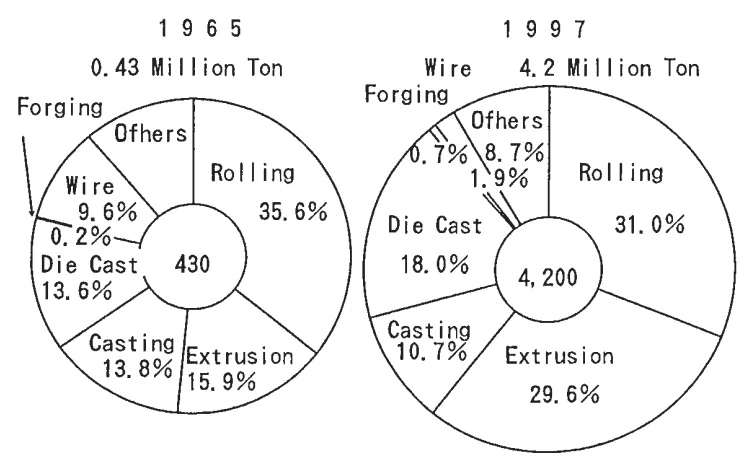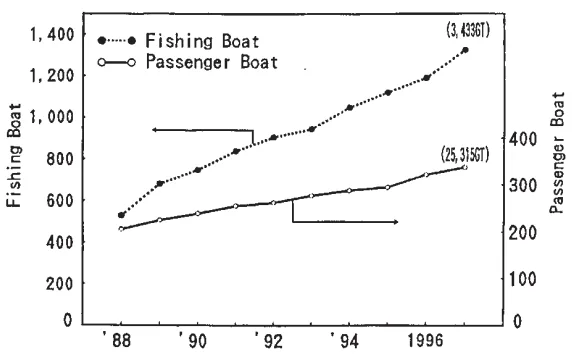This introduction paper is based on the paper "THE STATUS OF THE ALUMINUM INDUSTRY IN JAPAN" published by "Proceedings of ICAA-6 (1998)".

1. Overview:
- Title: THE STATUS OF THE ALUMINUM INDUSTRY IN JAPAN
- Author: Eiki Usui
- Year of publication: 1998
- Journal/academic society of publication: Proceedings of ICAA-6
- Keywords: Japan, aluminum industry, history, demand, equipment, technical development
2. Abstract:
The Aluminum industry in Japan has twice experienced a fatal breakdown in the past. There are no longer any aluminum smelting industries except one. However, aluminum consumption per person has grown to be the largest in the world today. In this report, firstly, the history of the aluminum industry in Japan, such as the progress of production technology and the growth of demand, is reviewed. Then, major equipment utilized in the industry is described. Finally, the issues for future development of aluminum industry in Japan are discussed.
3. Introduction:
Although the production of aluminum raw ingot in Japan is no more than 0.5% of total demand, the growth rate of final products has always exceeded the growth of GNP. By reviewing the history of aluminum in Japan, I would like to present the status of the industry, in terms of equipment, technology, and demand. Also, I would like to address the issues for tomorrow's aluminum industry.
4. Summary of the study:
Background of the research topic:
The Japanese aluminum industry has a unique status, having moved from smelting to a processing-focused industry with high per capita consumption. This paper reviews its historical development, current state, and future challenges.
Status of previous research:
The paper references historical data on production, demand, and technological milestones in the Japanese aluminum industry. It also refers to statistical data from various Japanese aluminum-related federations and associations.
Purpose of the study:
The purpose of this report is to review the history of the aluminum industry in Japan, describe the major equipment utilized, and discuss issues for future development. This includes presenting the status of the industry in terms of equipment, technology, and demand.
Core study:
The core study involves a historical review of the aluminum industry in Japan, covering its introductory stage, the history of the smelting industry, trends in demand for aluminum products, and the equipment and production in various sectors like rolling, extrusion, casting, die casting, forging, and wire. It also analyzes market trends and discusses key issues for future development in areas such as raw materials, melting and casting, rolling, extrusion, heat treatment, forming and joining, surface treatment, numerical analysis technology, multi-functional materials, and environment and health.
5. Research Methodology
Research Design:
The paper is a descriptive review, compiling and presenting historical and current data on the Japanese aluminum industry.
Data Collection and Analysis Methods:
Data was collected from historical records, industry statistics published by organizations such as the Japan Aluminum Federation, Japan Light Metal Association, The Japan Light Metal Welding and Construction Association, Japan Automobile Manufacturer's Association, Inc., and The society of Japanese Aerospace Companies, Inc. The analysis involves presenting trends and discussing developments based on this data.
Research Topics and Scope:
The research covers the history of the aluminum industry in Japan, including production technology progress and demand growth. It details major equipment used and discusses future development issues. The scope includes smelting, rolling, extrusion, casting, die casting, forging, wire production, market trends for major aluminum products (automotive, railroad cars, ocean vessels, aircraft/space, construction, food, electronics), and technical development issues.
6. Key Results:
Key Results:
Japan's aluminum industry has shifted from smelting to a processing-focused industry, with per capita consumption being the world's largest since 1989 (Fig.8). Raw ingot production is minimal, with most raw material being imported (Fig.2). Demand for aluminum products reached 4 million tons in 1996 (Fig.3), with significant growth in rolled, extruded, and die-cast products (Fig.4). The automotive industry is a major consumer, with an increasing aluminum application ratio in passenger cars (Fig.10, Fig.11). Key future issues include recycling, advanced processing technologies, and developing new applications.
Figure Name List:



- Fig.1 Aluminum Raw Ingot Prodcuction in Japan
- Fig.2 Aluminum Raw Material Supply(1997)
- Fig.3 Growth of Aluminum Demaud
- Fig.4 Growth of Aluminum Production (Breakdown)
- Fig.5 Growth of Rolled Products
- Fig.6 Growth of Extrusion Products
- Fig.7 Die Cast Machine Distribution
- Fig.8 Aluminum Cousumption Per Person
- Fig.9 Growth of Aluminum Production by Market
- Fig.10 Growth of Aluminum for Automotive Industry
- Fig.11 Aluminum Ratio in Passenger Cars
- Fig.12 Growth of Aluminum Railroad Cars
- Fig.13 Number of Aluminum Boats
- Fig.14 Growth of Aluminum in Food, Beverage Market
7. Conclusion:
The Aluminum industry in Japan is basically a complete processing business with the exclusion of smelting. Therefore added value is small. Also, price is decreasing rapidly. Needless to say, technical development for cost reduction is important. However, in order to make the aluminum industry the business that is worthy of world top aluminum consumption per person, increasing value by adding new functions and higher utilization by developing new application are our direction.
8. References:
- Ryoutaro Shiba : "The last Shogun"
- Altopia, (1997) Mar. 86
- ibid, (1997) Aug. 20
- ibid, (1997) Dec. 9
- ibid, (1997) Nov. 15
- Aluminum Statistical Review : 1995
- Hisashi Ohara : Private Communication
- Masao Tomeoka : Alumiproducts, (1997) June 11
- Alumiage, No.135
- Fujio Murata : Aluminum, 2 (1995), No.4, 141
9. Copyright:
- This material is a paper by "Eiki Usui". Based on "THE STATUS OF THE ALUMINUM INDUSTRY IN JAPAN".
- Source of the paper: [The provided image is of a paper from "Proceedings of ICAA-6 (1998)", a DOI URL is not available in the provided text.]
This material is summarized based on the above paper, and unauthorized use for commercial purposes is prohibited.
Copyright © 2025 CASTMAN. All rights reserved.
Paper Summarize:
This paper, "THE STATUS OF THE ALUMINUM INDUSTRY IN JAPAN," reviews the historical development, current status, and future prospects of Japan's aluminum sector. Despite the collapse of its smelting industry, Japan has become the world's largest per capita consumer of aluminum, focusing on processing and technological advancement. The paper details the growth in demand, particularly in automotive, construction, and packaging, and outlines the key technological challenges and development directions for the industry.
Key questions and answers about the research:
The paper "THE STATUS OF THE ALUMINUM INDUSTRY IN JAPAN" outlines the evolution of Japan's aluminum sector from a smelting industry to a leading processing and consumption market. It highlights that despite minimal raw ingot production, Japan's per capita aluminum consumption is the highest globally, driven by technological advancements and growing demand in various sectors. The research identifies key areas for future development, including recycling, advanced material processing, and the creation of new applications to enhance value.
Q1. What is the current status of aluminum smelting in Japan?
A1. There are no longer any aluminum smelting industries in Japan except for one, Nippon Light Metal, which has an in-house power supply system. (THE STATUS OF THE ALUMINUM INDUSTRY IN JAPAN, Section 3. HISTORY OF THE SMELTING INDUSTRY)
Q2. How does Japan's aluminum consumption per person compare globally?
A2. Aluminum consumption per person in Japan has been the highest in the world since 1989. (THE STATUS OF THE ALUMINUM INDUSTRY IN JAPAN, Section 6. MARKET TREND OF MAJOR ALUMINUM PRODUCTS, Fig.8)
Q3. What are the main sources of aluminum raw material for Japan's industry?
A3. In 1997, 77.1% of aluminum raw material was imported, with domestic production (including recycled ingot) accounting for 22.9%. (THE STATUS OF THE ALUMINUM INDUSTRY IN JAPAN, Section 3. HISTORY OF THE SMELTING INDUSTRY, Fig.2)
Q4. Which sectors have shown remarkable growth in aluminum product consumption in Japan?
A4. Rolled, extruded, and die cast products have grown remarkably. Specifically, demand in transportation, construction, and food areas has significantly increased their share between 1965 and 1997. (THE STATUS OF THE ALUMINUM INDUSTRY IN JAPAN, Section 5. EQUIPMENT AND PRODUCTION IN ALUMINUM INDUSTRY, Fig.4 and Section 6. MARKET TREND OF MAJOR ALUMINUM PRODUCTS, Fig.9)
Q5. What is a key trend in the automotive industry regarding aluminum usage in Japan?
A5. The demand for aluminum in the automotive market has grown significantly, and the aluminum application ratio in passenger cars is increasing, with forecasts suggesting it might exceed 15% in the near future. (THE STATUS OF THE ALUMINUM INDUSTRY IN JAPAN, Section 6.1 Transportation (1) Automotive industry, Fig.10, Fig.11)
Q6. What are the primary future challenges and directions for the Japanese aluminum industry?
A6. Key issues include enhancing recycling technologies, developing advanced technologies for melting, casting, rolling, and extrusion, and creating new applications and multi-functional materials to add value, as the industry is primarily a processing business with small added value. (THE STATUS OF THE ALUMINUM INDUSTRY IN JAPAN, Section 7. ISSUES and Section 8. SUMMARY)